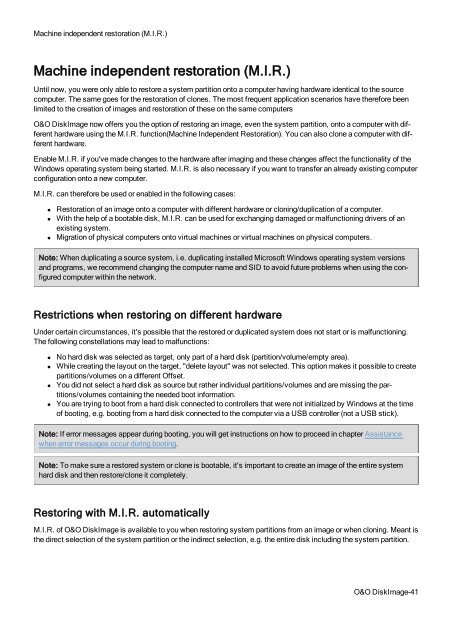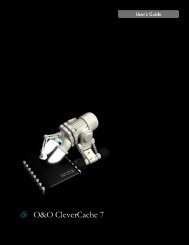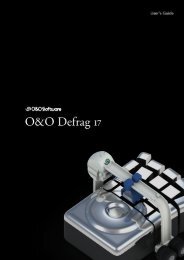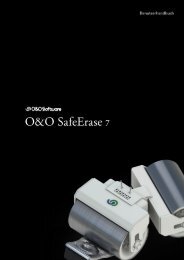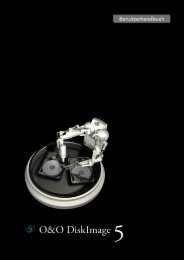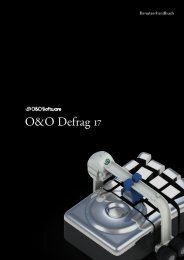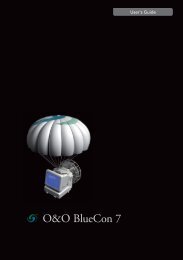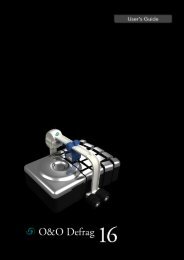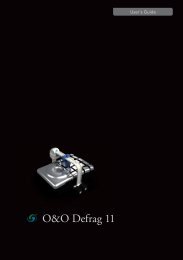O&O DiskImage 7 User's Guide - O&O Software
O&O DiskImage 7 User's Guide - O&O Software
O&O DiskImage 7 User's Guide - O&O Software
Create successful ePaper yourself
Turn your PDF publications into a flip-book with our unique Google optimized e-Paper software.
Machine independent restoration (M.I.R.)<br />
Machine independent restoration (M.I.R.)<br />
Until now, you were only able to restore a system partition onto a computer having hardware identical to the source<br />
computer. The same goes for the restoration of clones. The most frequent application scenarios have therefore been<br />
limited to the creation of images and restoration of these on the same computers<br />
O&O <strong>DiskImage</strong> now offers you the option of restoring an image, even the system partition, onto a computer with different<br />
hardware using the M.I.R. function(Machine Independent Restoration). You can also clone a computer with different<br />
hardware.<br />
Enable M.I.R. if you've made changes to the hardware after imaging and these changes affect the functionality of the<br />
Windows operating system being started. M.I.R. is also necessary if you want to transfer an already existing computer<br />
configuration onto a new computer.<br />
M.I.R. can therefore be used or enabled in the following cases:<br />
• Restoration of an image onto a computer with different hardware or cloning/duplication of a computer.<br />
• With the help of a bootable disk, M.I.R. can be used for exchanging damaged or malfunctioning drivers of an<br />
existing system.<br />
• Migration of physical computers onto virtual machines or virtual machines on physical computers.<br />
Note: When duplicating a source system, i.e. duplicating installed Microsoft Windows operating system versions<br />
and programs, we recommend changing the computer name and SID to avoid future problems when using the configured<br />
computer within the network.<br />
Restrictions when restoring on different hardware<br />
Under certain circumstances, it's possible that the restored or duplicated system does not start or is malfunctioning.<br />
The following constellations may lead to malfunctions:<br />
• No hard disk was selected as target, only part of a hard disk (partition/volume/empty area).<br />
• While creating the layout on the target, "delete layout" was not selected. This option makes it possible to create<br />
partitions/volumes on a different Offset.<br />
• You did not select a hard disk as source but rather individual partitions/volumes and are missing the partitions/volumes<br />
containing the needed boot information.<br />
• You are trying to boot from a hard disk connected to controllers that were not initialized by Windows at the time<br />
of booting, e.g. booting from a hard disk connected to the computer via a USB controller (not a USB stick).<br />
Note: If error messages appear during booting, you will get instructions on how to proceed in chapter Assistance<br />
when error messages occur during booting.<br />
Note: To make sure a restored system or clone is bootable, it's important to create an image of the entire system<br />
hard disk and then restore/clone it completely.<br />
Restoring with M.I.R. automatically<br />
M.I.R. of O&O <strong>DiskImage</strong> is available to you when restoring system partitions from an image or when cloning. Meant is<br />
the direct selection of the system partition or the indirect selection, e.g. the entire disk including the system partition.<br />
O&O <strong>DiskImage</strong>-41


